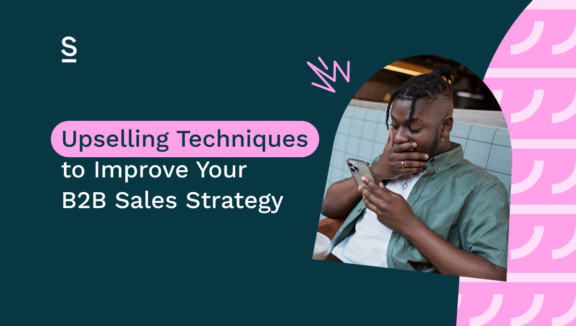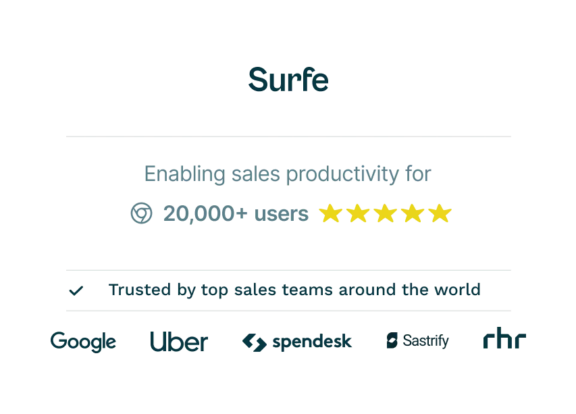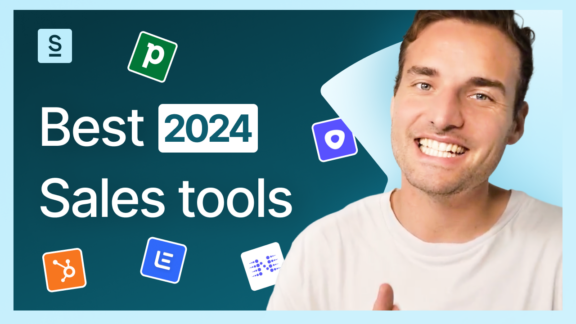Upselling Techniques to Improve Your B2B Sales Strategy

Ever got to a stage in your career where you’re just…comfortable?
You know your market and your customers inside out. You’re hitting your targets. Your team’s doing well. Sure, you occasionally come up against some tricky moments, but you know how to handle yourself. Life is, well, pretty good.
Now, we’re not going to pretend that this doesn’t sound bad – quite the opposite, in fact. But if you’re an ambitious sales pro, which we’re sure you are, it won’t take long before you’ll start looking to take your achievements to the next level.
This is when upselling enters the room. Think of every upsell you make as an opportunity to get even better at what you do – to provide maximum value for each customer, and get maximum revenue out of them in the meantime.
Even if you’re not at the everything’s-rosy stage of your career yet, it’s still incredibly beneficial to get into the upselling mindset. Using upselling techniques is an efficient way of doing sales: your business will spend less on acquiring new prospects and you’ll spend less time on building new relationships. All this while your MRR figures go through the roof. Sounds even sweeter to us.
Ready to dive into the wonderful world of upselling? Here’s what we’re going to cover:
- What is Upselling?
- Top Upselling Techniques for a Solid Sales Strategy
- When to Address Upselling
- Tools to Use for Upselling
- 5 Secret Tricks that 95% of People Don’t Know
Let’s take your sales to the next level.
What is Upselling?
First things first, let’s get our definitions straight. When you upsell a prospect, you’re encouraging them to buy a better, more expensive version of what they were originally looking to buy.
The first time you speak to a prospect, it’s likely that they’ve had a look at your pricing page and decided to purchase the cheapest option for their needs. It’s your responsibility to show them why spending more than they originally intended will actually deliver more value. Simple!
Need a few examples of Upselling techniques? We’ve got you:
- Offering a more expensive pricing package or extra services
- Offering a discount if your prospect purchases multiple products
- Creating a personalized offer or program just for your prospect
Wondering why upselling is so important? Think about it this way: if you don’t upsell to a prospect, you’re leaving money on the table – and denying your prospect a better experience that they might know nothing about. Other benefits include:
- Increased revenue – and therefore profit: if your prospect spends more money, that’s going to positively impact your bottom line (and your commission).
- Happier customers: think about the last time you bought something that was just perfect for your needs. Now think about making your prospects feel that way.
- Demonstrated product range: by showing off all the bells and whistles, you’re showing the prospect just how amazing your product is. You want to keep perceived value high, to make sure your clients actually stick around.
What’s the Difference Between Upselling and Cross-Selling?
Ok, so you know what upselling is and what the best upselling techniques are (we hope so, anyway). Is it the same thing as cross-selling?
Nope. If you cross-sell, you’re offering your customers extra products that complement their original purchase. As the suite of products you sell are all complementary, it’s likely that the customer’s going to have a better, more fruitful experience if they use more of them.
Cross-selling always happens after the original sale, and may be the responsibility of your Customer Service team – or, depending on the size of your business – your Inside Sales team.
Top Upselling Techniques for a Solid Sales Strategy
If you bulldoze your way into every conversation pushing an upsell, you’re not going to get very far. In fact, you might find yourself with no prospects – they’ve all gone to your competitor in disgust.
Obviously we want to avoid that. Let’s take a look at some of the best upselling techniques for nailing your sales strategy:
- Understanding your customers’ needs: if you’re good at sales (of course you are), you’ll be doing this anyway. Research them thoroughly, and make sure you’re well acquainted with their unique challenges and needs. Once this is complete, you’ll be in a good place to understand what kind of upsell will work for them.
- Establish trust and credibility: we all know the (unhelpful and inaccurate) stereotype of a slimy salesperson who only cares about getting the money. Position yourself as the opposite of this: more of a trusted partner who your prospects genuinely value talking to, and your upsell suggestions will be far better received.
- Personalize your offers: hopefully you’ve picked this one up by now, but just in case we need to spell it out – the upsell has to make sense for your customer. Use your CRM data to understand their unique needs, and use this to inform what you suggest next. Solid upsell strategy right there.
- Provide demonstrations and free trials: upselling is still selling, after all. Approach it like you’re introducing your product for the first time – demonstrate how it works and let your prospects try everything out for themselves, and you’re reducing perceived risk and showing off its value.
- Leverage automation and AI: upselling requires the personal touch, but there’s no harm in getting a little technological help along the way 😉use automation tools and your tech stack’s AI capabilities to pull these opportunities out of your records – then use your charm and charisma to seal the deal.
When to Address Upselling
Time for the next part of the upselling technique strategic puzzle: timing. You need to pinpoint exactly the right moments in the customer journey for an upsell. Here’s where buyer intent data comes into its own.
A quick definition: buyer intent data refers to the signals that a prospect makes when they’re ready to make a purchase. Keeping an eye on it is a bit like reading their mind – you’ve spotted an opportunity and know exactly what to do next to maximize it.
There are two types of buyer intent data: first-party data and third-party data. You get first-party data directly from your prospects – think their activity on your website, your CRM or your email interactions. Third-party data comes from sources like specialized data providers or industry platforms.
Examples of buyer intent triggers include:
- Product usage patterns: you can see they’re using your product a lot – and we mean a lot. Maybe they’d benefit from an extra seat for their colleague, or maybe their favorite feature has a cousin you think they’d also get value out of.
- Great feedback: you only hear positives – perhaps they LOVED the free trial, or they mention it’s exactly what they’re looking for.
- A change in priority or strategy: particularly in the world of B2B, where sales cycles can be looooong, things with your prospect might change. If they mention the strategy’s changing, or their CEO wants a renewed focus on one of their challenges, think about a more advanced version of your product can help support it.
- Business growth: just heard that your target business has closed a new funding round, or is hiring? Chances are, they’ll need some more powerful tech to support this growth – and they’ll also have money to spend.
- Referrals: this is another signal that your prospect’s really, really excited about your product. Make sure you capitalize on it.
Tools to Use for Upselling
The best technologies you can use to help you with upselling techniques are your CRM and your marketing automation tools.
You might use Hubspot and ActiveCampaign, for example – or perhaps you’re more of a Salesforce and Omnisend type of sales pro.
The combination of these tools will use algorithms and data analysis to figure out what extra purchases your prospects might benefit from, and deliver the results to you ready to use.
When getting this all set up, we’d recommend segmenting your audience to help you spot the contacts who might be interested in an upsell. For example, if you have a segment of customers that tend to spend more money with you – maybe they’re in a specific industry – then similar profiles will be good to keep an eye on.
You can also indicate what upsells they might be interested in, to make the process even speedier. Magic.
You’ll also want to take a look at the integrations that help your CRM and automation tools do their best work.
Let’s take the example of Surfe – it’s the one we’re most familiar with, after all. Surfe is a data enrichment tool that keeps your contact data up-to-date, and accurate – and syncs it all automatically up to your CRM. This accurate data’s then going to inform the basis of the decisions your tools make – and ultimately, the upselling techniques that you use.
5 Secret Tricks that 95% of People Don’t Know
Want to take your upselling technques to the next level? Stupid question, we know. Here’s how:
Advanced Segmentation
You’re already familiar with this one. The more effectively you can segment your customers, the more easily you’re going to be able to identify high-potential upsell opportunities. Plus, they’re more likely to be well-received, as they’ll feel super personal.
Behavioral Triggers
Set triggers up, and you can go about your business safe in the knowledge that your upsell conversations are going to be identified and initiated for you. To take a very basic example, if a prospect’s suddenly checking out the pricing page on your website a lot, your automation tool might ping them an email inviting them to learn more about their options.
Utilize Social Proof
People are sheep. A sad fact, but a true one. If you can prove just how amazing this upgraded product is by explaining what it’s already done for other customers, you’ll be in the money. Your prospect will be more likely to be convinced, as they’ll look to their peers to help them make a decision. Testimonials and case studies do a great job here – or perhaps they could even speak to a current user? Let’s move onto the next upselling technique.
Incentivize Upsells
Here’s another fact about human beings (full of them today, aren’t we). They love to feel like they’ve got a good deal on something. If you can attach your upsell to a discount or free trial, and you know your product’s good enough to keep them around long-term, it’s likely you’ll get more value out of them than the initial discount cost you.
Post-Purchase Follow-Up
Here’s a nice easy one to make part of your routine. Implement a structured post-purchase follow-up process, and you’re automatically gaining information from your customer on the best move for you to make next. For example, if they mention they’d love to see more of a certain result, you can jump in and explain how an extra purchase might help them get there.
Let’s Wrap It Up!
Ready for your next challenge – and to enter the sales hall of fame? Introducing upselling techniques might just be your golden ticket. Keep the needs of your customer front-of-mind at all times, and use a little help from your tools and tech where necessary, and you’ll have upsell opportunities coming at you from left, right and center.
See you on the other side.

Ready to put your new upselling techniques into practice?
Start off with Surfe – it’ll help you get your CRM data in tip-top shape. Plus, it’s free – just hit the button below to get started.
FAQs About Upselling Techniques
What is upselling in B2B?
Upselling in B2B refers to when you convince your prospect to purchase a more expensive version of your product than they were originally planning to. As a sales professional, you should do this when you truly believe they will get more value out of the more expensive version. Upselling shouldn’t be confused with cross-selling, which occurs when a team sells a different, but related product to the original to the prospect.
How Do You Use Upselling Techniques to Upsell to Existing Customers?
Upselling to existing customers can be done by leveraging buyer intent data. You might get this from your CRM or from interactions you have with your prospects. If they show signs of being ready to purchase an upgrade, you (or your marketing automation tool) should trigger a conversation where you introduce them to the benefits.
How can I improve my B2B selling?
One way to improve your B2B selling is to always keep an eye out for upsell opportunities. If you’re getting more value out of one customer, you’re selling more efficiently – and providing even more value to your prospects in the first place. It’s important to get the timing right and provide personalized upsell suggestions to each prospect, to make sure that your offer will be well-received.



